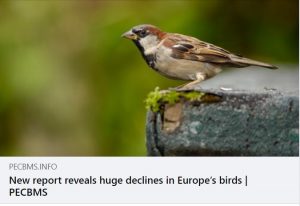Report on the Pan-European Common Bird Monitoring Scheme, December 2021
January 12, 2022
We have made many innovations to our tools and dataset in this period, which led to improved supranational species indices and indicators, speeded up the process of data gathering, data control and calculations. In the 2021 update released on 6 December, we included two new monitoring schemes' data from Croatia and Flanders, so the outputs are based on data covering 40 years from 29 countries including 26 EU MS – all but Malta, where no regular bird monitoring scheme is running. We updated the network with regular newsletters and web articles. The PECBMS data was used in two scientific papers published in respected peer-reviewed journals. We contacted all EU MS coordinators and agreed on national indicators delivery for policy purposes via PECBMS. Moreover, we gathered all national farmland bird indicators produced so far and the species lists behind them. We met EU stakeholders several times and provided answers and advice upon request. Finally, we attended EBCC Board meeting and presented the progress of the PECBMS.

On 6 December, we presented updated population trends and indices of 170 common European bird species and common European bird indicators for the period 1980–2019.
This report summarises the Pan-European Common Bird Monitoring Scheme (PECBMS) activities between 16 June 2021 and 16 December 2021.
Project funding
The project is secured by the EC tender called “Technical and scientific support in relation to the delivery and development of wild bird indicators for the EU“.
Production of European species trends and indices
On 6 December, we presented updated population trends and indices of 170 common European bird species for the period 1980–2019. The species trends shown on the website are for a long time period (from 1980 onwards until 2019) and the last ten years (2010–2019).
In 2021, a reliable European index was produced on 170 species, which is the same number of species as in the last update in 2020.
This time, we added new data to our dataset: Croatia delivered their data for 2015–2019 and Belgium region Flanders contributed with scheme data for the period 2007–2019 (which means that since this update, Belgium as a country is completely covered by three regional schemes: Brussels, Wallonia and Flanders).
The list of 29 countries provided their data for this update: Austria, Belgium, Bulgaria, Croatia, Cyprus, Czech Republic, Denmark, Estonia, Finland, France, Germany, Greece, Hungary, Italy, Latvia, Lithuania, Luxembourg, Netherlands, Norway, Poland, Portugal, Republic of Ireland, Romania, Slovenia, Slovakia, Spain, Sweden, Switzerland, United Kingdom.
The website table summarises the updated European species indices, long-term and ten-year trends and slopes, and species habitat classification.
Indices and trends for 170 European bird species are now freely available for download in Excel sheets (Data Provision and Co-Authorship Policies applies).
Production of EU and European multi-species indices (indicators)
On 6 December, we published the new European Common Bird Indicators. The 2021 update is based on data from 29 countries from 1980 to 2019.
We computed the indicators for Europe (Fig. 1) and its regions (West, North, Central & East and South Europe), EU, New and Old EU states for common farmland, forest, and all common birds. We used the Single European and BioGeo regional species habitat classifications to assess whether each bird species belongs to farmland, forest, or another indicator.
We used the indices of common European birds to compute European indicators. Although we produce indices for 170 species, we remove Cyprus wheatear Oenanthe cypriaca and Cyprus warbler Sylvia melanothorax from the computation of the indicators because the two species are endemic in Cyprus. Therefore, we included only 168 species in the common bird indicators.

Fig. 1 European Common Bird Indicators (1980–2019). All common species (168) are shown in the blue line, common forest species (34) in the green line, and common farmland species (39) in the red line.
We published the main European, EU, and regional smoothed indicators in the website tables. In addition, the main indicators for Europe and the EU are now freely available for download in Excel sheets (Data provision and co-authorship policies apply).
Dataset revision and Technical improvements
We implemented a new tool (in an R-script) gathering criteria used to select national data. This tool points out the problematic data on a national level to assess its use for supranational index calculation.
Since all the tools for national indices, supranational indices and indicator calculation are R-scripts, there was a need to create a database in R as well. This way, we reached simplification and speeding up of database creation.
We checked and updated bird names according to the HBW and BirdLife Taxonomic Checklist v6. We requested new EURING codes for the species previously lacking a code and incorporated them in the database. We unified the terminology and assessed the new subspecies or species within 170 PECBMS species. It was the case of Phylloscopus bonelli, Sylvia hortensis and Phylloscopus collybita. There was no need to split one species into two because the data we receive always fall under the original species’ name.
The thorough data revision led to
- data improvement on the national level due to comprehensive data assessment and time to discuss with national coordinators
- improved data used for index and indicator calculation
- update of tools used for data processing and calculation
- a thorough revision of the PECBMS candidates; we have already involved Croatia in PECBMS, and we assess data from Russia and Andorra for implementation in the future updates
- simplification and speeding up the process from national index calculation to publishing on PECBMS web
Besides this, computation procedure, data quality control and presented indices, trends and indicators are generally consistent with the update in 2019. All the inconsistencies are justified by data selection and new countries joining PECBMS.
Furthermore, we revised also the PECBMS site-level database, which consists of annual bird abundances at georeferenced census sites from 31 monitoring schemes (29 European countries). It contains information from 25,666 locations and 497 species. We conducted data quality controls, including checking and fixing data for taxonomical inconsistencies. The update of the site-level data has been performed in parallel with the development of the site-level data online tool, which allows more efficient data checks and management, and communication with national coordinators.
Presentation of results and promotion
PECBMS contributed to the summer, autumn and winter issue of the EBCC Newsletter spread to more than 600 recipients. See an archive of the newsletter.

PECBMS website www.pecbms.info has been actualised regularly. In the given period we published 12 news, updated the list of publications, PECBMS methods, and the information on the bird monitoring schemes in Europe and national indicators. We also created a new page presenting the national coordinators of European bird monitoring schemes in the PECBMS, regularly updated and filled with new portraits. So far, the coordinators from Czechia, Estonia, and Italy are presented.
To address the wider public, we maintained the Facebook and Twitter profiles and updated the posts regularly every week – 42 news from 16 June 2021 until 16 December 2021.
Research
On 2 November, we published a study in Nature Communications that reveals that spring sounds are changing, with dawn choruses across North America and Europe becoming quieter and less varied. We joined an international team of researchers led by UEA. We developed a new technique, combining bird monitoring data (gathered thanks to citizen science projects) with recordings of individual species in the wild, to reconstruct the soundscapes of more than 200,000 sites over the last 25 years.
On 15 November, we published a study on breeding birds in the EU, which shows one out of every six birds over nearly 40 years has been lost. Overall, we have lost around 600 million breeding birds in the EU since 1980. We joined a team of scientists comprising European collaborators from RSPB, BirdLife International and the Czech Society for Ornithology. We analysed data for 378 out of 445 bird species native to countries in the EU. The study was compiled using data from the PECBMS and mandatory reporting by the EU Members States to the European Commission under the EU Birds Directive.
We participate in a project called Turtle dove migration – a proposal for the delineation of flyways led by Hervé Lormée from Office Français de la Biodiversité and Carles Carboneras from Instituto de Investigación en Recursos Cinegéticos. We delivered the 10-yr multiplicative trend of the populations flying the western and the central-eastern flyway.
We participate in the NERC project to advance the understanding of stability within and among ecosystems and across ecological scales, led by RSPB and the University of Sheffield.
PECBMS data was used in the following publications:
- Burns F., Eaton M. A., Burfield I. J., Klvaňová A., Šilarová E., Staneva A., Gregory R. D. 2021. Abundance decline in the avifauna of the European Union reveals global similarities in biodiversity change. Ecology and Evolution. https://doi.org/10.1002/ece3.8282

- Morrison, C.A., Auniņš, A., Benkő, Z., Brotons, L., Chodkiewicz, T., Chylarecki, P., Escandell, V., Eskildsen, D.P., Gamero, A., Herrando, S., Jiguet, F., Kålås, J.A., Kamp, J., Klvaňová, A., Kmecl, P., Lehikoinen, A., Lindström, Å., Moshøj, C., Noble, D.G., Øien, I.J., Paquet, J-Y., Reif, J., Sattler, T., Seaman, B.S., Teufelbauer, N., Trautmann, S., van Turnhout, C.A.M., Voříšek, P., Butler, S.J.: Bird population declines and species turnover are changing the acoustic properties of spring soundscapes. Nature Communications 2021(12):6217. DOI: 10.1038/s41467-021-26488-1

Maintain and update the network of cooperating organisations and individuals
Up to date, the PECBMS list of contacts contains 912 individual references from 64 countries or territories, of which 377 are on the PECBMS mailing list, including coordinators of national monitoring schemes, EBCC national delegates, and BirdLife partner organisations, as well as policy people and decision-makers.
The information on monitoring schemes was regularly updated in full compliance with the General Data Protection Regulation (GDPR).
We provided advice and consultations to the national coordinators upon request on the Online Tool and data delivery (various national coordinators); data quality (Belarus, Andorra); methods (Bulgary); the national FBI and Forest bird indicator (Lithuania) and various other topics (Germany, Luxembourg).
We continued developing the new project, International Census Plots which aims to support common bird monitoring schemes in southern and eastern Europe. Our colleagues in Serbia (Bird Protection and Study Society of Serbia, BPSSS) successfully finished the pilot year 2021, in which 27 volunteers participated, who visited twice 34 transects. We regularly meet Serbian colleagues and assist them with designing the scheme. Up to date, 28 volunteers participated, who counted 33 transects.
Based on the experience from Serbia, we invited other countries to participate. On 3 December, we met a colleague from Monte Negro to start discussing the development of monitoring. On 15 December, we met colleagues from Moldova to begin developing a regular bird monitoring scheme in their country.